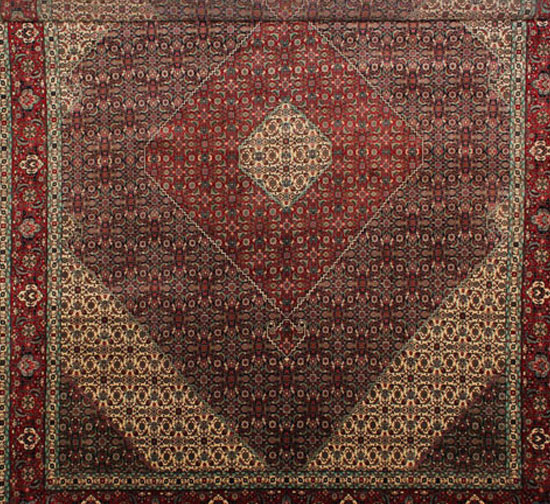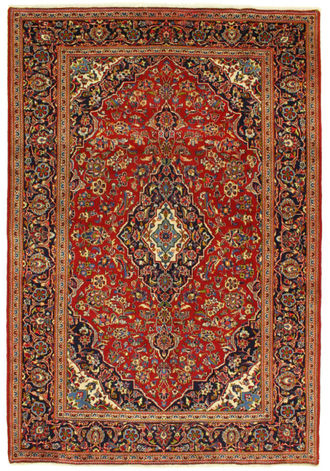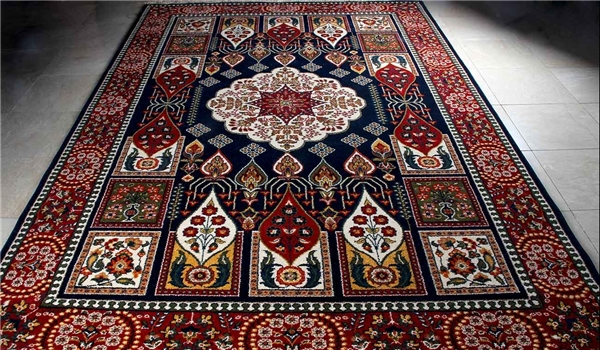
The Iranian carpet designs
are divided into 19 main groups and each are subdivided into several smaller
branches:
Designs of Antiquities and Islamic Buildings: These designs are
inspired by buildings, tiles, geometrical and decorative forms of buildings. Of
course, carpet designers have made some changes to their designs, but the
original structure of the carpet layout has been completely preserved. The most
famous of these works are Sheikh Lotfollah Mosque, Mehrabi Kufi, Kabood Mosque,
Sheikh Safi's Tomb, Imamzadeh Mahrouq Sardar, Gonbad Qaboos, Shah Isfahan
Mosque, Takht-e Jamshid, Taq Bostan, Kasrai (Ivan Madaen) and ...
Shah Abbasi designs: The basis of all Shah Abbasi designs is based on the use of
Shah Abbasi's famous flower in this design. In these designs, the flowers of the
Shah Abbasi, along with the Khatti straps and sometimes their combination with
the Islami, offer different types of carpet designs. Usually Qom carpets have
these designs.
Types of designs in this group include Shahab Abbasi bush, Afshan Shah Abbasi,
Shah Abbasi tree, Shah Abbasi Sheikh Safi, Shah Abbasi animal and so on. . .
Islamic Designs: The main form of this design is the circular branches between
the leaves. Islam has many varieties, one of the most famous of Islamic designs
being the Torah of Islam. In this type of slimy, the end of each branch is split
into two symmetrical sections and represented as a jaw dragon. Other Islamic
designs include slimming, slimming, slimming and bergamot.
Spray Pattern: This is how the flowers and leaves and branches are sown
sporadically, without attachment to each other in the carpet text. The designs
are basically designed in such a way that none of the flowers and leaves are
symmetrical and there are no principles of mirroring. Different types of
spraying designs are:
Such as Islamic spray, Khalati spray, Splash, broken spray, Pomegranate spray,
Shah Abbasi spray, twig branch spray, Bouquet spray, Animal spray and Berg
spray.
Derivative Plans: Most of the designs in this group are said to resemble the
designs of carpets in the border regions of Iran, and neighboring countries, and
even other countries, and are therefore called derivatives, such as the
designs known as Caucasian and Gobelin.
Beetle Designs: All designs by this group are based on Beetle use. The most
popular Beta designs include Beta Jake, Bose Horn, Beta Terme, Beta Sarabandi,
Bora Khorak, Beta Khamkar Isfahan, Eight Goals, Beta Kordestan or Eight Beta,
Beta Mir Mir, Beta Lachak Bari, Beta Sanjay, Armband and almond bush.
Wraparound or Layout Designs: The term used is to repeat a small piece of a
pattern across the rug, both in length and in width. Because these pieces are
intertwined in the iteration phase, they are called segments or divisions.
The main categories of this group are: Islamic classification, adobe
classification, trilingual classification, milk and sugarcane classification,
deer branching, mulching classification, enamel classification and ...
Tree designs: Although the design of the carpet is based on the branches
and leaves. In this group's designs, small and large trees and shrubs,
especially individually, form the main composition and are combined with other
components. Some of the popular tree designs that can be mentioned are: animal or
animal tree, vegetable or waterfront tree, bergamot tree, survey tree, and
potted tree.
Hunting Plans Occasionally: The main foundation of this group of projects
is hunting and hunting scenes. In most hunting designs, wild animals are hunted
for cover. The subgroups of the project include the tree hunt, the bounty
hunter, the bounty hunter, the lynx bounty hunter, and the national hunt. These
specimens are also found in Qom and Tabriz carpets.
Brick or marble designs: The carpet text in these designs is divided into
different sections or frames that are regularly aligned. Its subgroups can be
called the Islamic frame, the Quranic Quran or the column.
Turkmen or Bukhara: Turkmen carpet designs are geometrically and fractured in
line with the tribal and tribal designs that are woven mentally and without a
map. Turquoise Yemoni, Turquoise Turquoise, Gazelle Turquoise, Akhali Turquoise,
Four Frame Turquoise, Sour Turquoise and Spoon Turquoise
Fish Scheme: Fish Scheme is one of the oldest and most common designs in
Iran. The design is often in the form of a carpet and the weaver repeats the
same carpet length and width. In this plan or divider, a pond is observed in a
rhombus with four leaves - fish around it.
Fish designs are known by various names in different
parts of Iran. The most important types are:
Farahan fish, honeycomb, Kurdistan fish and petite fish
13Roses: The designs of this group are based on natural flowers especially
roses with very bright colors such as yellow, blue and red
14Vase Design: One of the features of this design is the existence of one or
more vases in the carpet text. Sometimes a large flower-filled vase covers the
entire carpet, and sometimes in vase designs, there is a large vase on one side
of the carpet whose flower branches cover the entire text of the rug. The most
famous designs of this group include pot of thousand flowers, pot of altar, pot
of celery, duplicate of pot, lachek bergamot and one pot.
Prohibition Designs: In this design, the entire text of the rug is divided into
several parallel rows longitudinally and decorated within these rows with
paintings such as jade beetle, Islamic or khatti varieties and other flowers and
leaves. In other words, the carpet text is striped, one of the most popular
designs of this group can be referred to as the Jet Bettet. Other designs in
this group include a global highlight, a pink one-color background and a beige
Alvan background.
16. Altar Designs: The design of this group is based on the altar. In
this group of designs, the altar is usually decorated with decorations such as
candlesticks, pots and shrubs. Types of projects in this group include:
Altar candy, altar alder, tree altar
17. Integrated Designs: These designs have evolved over time and integrate
different designs. Among the designs in this group can be mentioned lacquered
and bergamot designs, flower bouquet, flower composition, geometric
composition and so on.
18. Geometric Designs: All of the drawings in these designs are
geometric and are created using angled lines. Important subgroups of the scheme
are: Frame geometry, Terrain geometry, Shroud geometry, Torch geometry (Broken
branch), Simple floor geometry, Error geometry, Star geometry (Mosaic), Khatam
Shirazi geometry and Welding geometry.
19. Tribal and Tribal Designs: This group of designs is one of the oldest and
most original designs of Iranian carpets that comes from the minds of indigenous
carpets inspired by their simple nature and life. The rule of order in such
designs does not make much sense. The oldest and most important subgroups of
such designs can be the designs of Hobeetloo (related to Fars and Abadeh),
Qashqai Beta, Afshari, Khatoni, Ardebil, Mazlaghan, Khamseh, Saveh, Tafresh,
Harris, Mehraban, Goravan, Zanjan and Meshkin Shahr, Bakhtiari, Kurdish, Yalmeh,
Gabbeh (Kharang), Sistan, Ferdows, Salarkhani, Yaghoub Khani, Wooden Stone, Ali
Mirzaei, Janbigi, Janmazzi, Jawain, Musa Abad, Baluchistan, Vis, Qorjeh, Sunna
and the bouquet.


